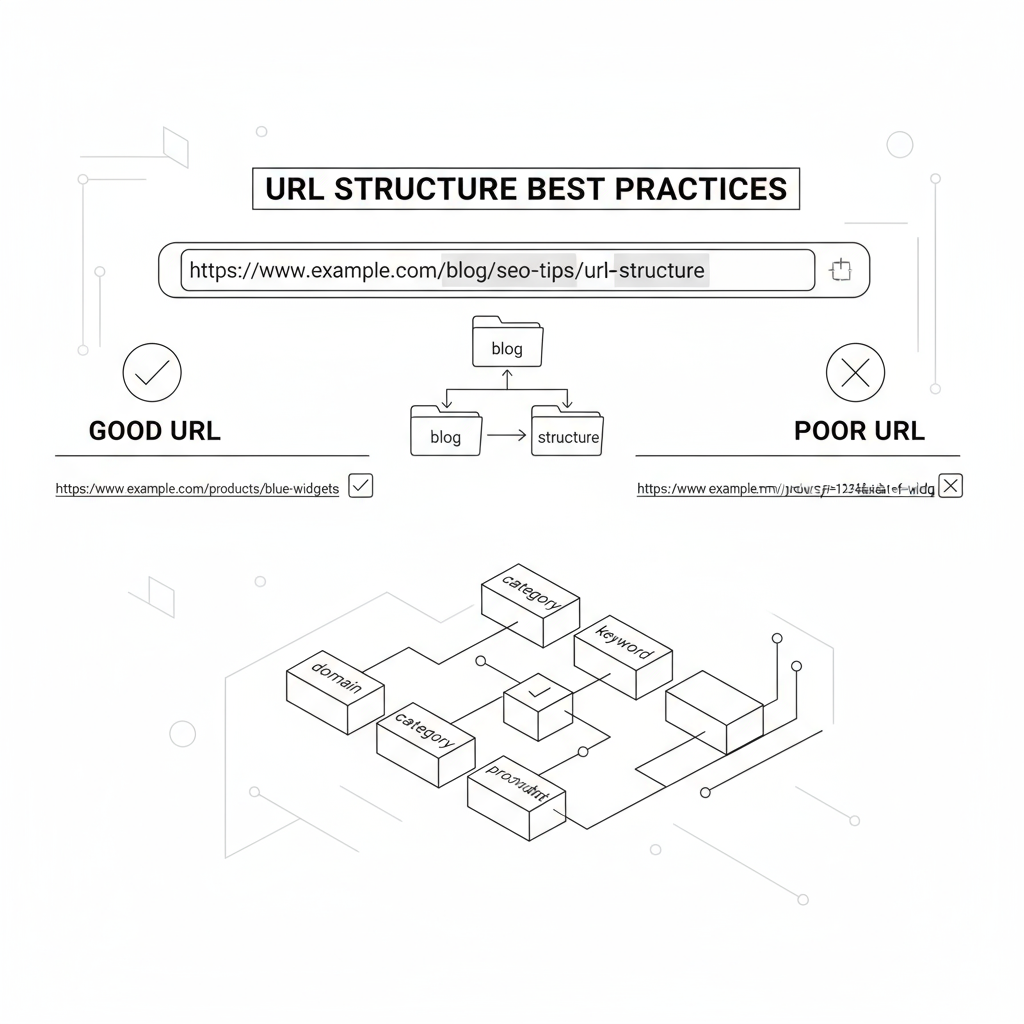Last Updated: October 24, 2025
Your website's URLs are more than just web addresses; they are the signposts that guide both users and search engines through your content. A well-structured URL provides context, improves user experience, and can even contribute directly to better search rankings. Conversely, poorly designed URLs – long, cryptic, full of parameters – create confusion, waste crawl budget, and hinder your SEO efforts.
While seemingly a minor detail, optimizing your URL structure is a foundational element of technical SEO and a key component of a strong site architecture. This guide outlines the definitive best practices for creating SEO-friendly URLs that are clear, concise, and built for long-term success.
Chapter 1: Why URL Structure Matters for SEO
Optimizing your URLs delivers several key benefits:
- Improved User Experience (UX): A clean, readable URL helps users understand what the page is about before they even click.
example.com/running-shoes/mens-nike-pegasusis far more informative thanexample.com/prod?id=8736. This builds trust and improves click-through rates (CTR) from SERPs. - Keyword Relevance Signal: Including relevant keywords in your URL provides a small but significant relevance signal to search engines. While not a major ranking factor on its own, it contributes to the overall understanding of the page's topic.
- Easier Sharing & Linking: Short, descriptive URLs are easier for users to copy, paste, and share on social media or link to from their own content.
- Site Structure Context: Using subfolders in your URLs (e.g.,
/category/sub-category/page) can reinforce your site's hierarchy for both users and search engines, aiding crawlability and understanding.
Chapter 2: The Anatomy of an SEO-Friendly URL: Best Practices
Follow these rules to create URLs that work hard for your SEO:
1. Keep Them Short and Simple
Shorter URLs are generally preferred. They are easier to read, share, and remember. Aim to remove unnecessary words (like "a," "the," "and") while keeping the core meaning intact.
- Good:
/technical-seo/crawl-budget-optimization - Bad:
/the-ultimate-guide-to-understanding-and-optimizing-your-sites-technical-seo-crawl-budget-in-2025
2. Be Descriptive & Include Keywords (Naturally)
Your URL should accurately reflect the page's content. Include your primary target keyword where it makes sense, but avoid keyword stuffing.
- Good:
/blog/how-to-improve-lcp - Okay:
/blog/lcp-improvement - Bad (Stuffing):
/blog/improve-lcp-largest-contentful-paint-fast-loading-speed
3. Use Hyphens (-) to Separate Words
This is the universally accepted standard. Google treats hyphens as word separators.
- Correct:
/running-shoes - Incorrect:
/running_shoes(Underscores are often treated as word joiners) - Incorrect:
/runningshoes(Harder to read)
4. Use Lowercase Letters Only
While URLs can be case-sensitive on some servers, using only lowercase letters prevents potential duplicate content issues where example.com/Page and example.com/page might be treated as separate URLs.
5. Avoid Unnecessary Parameters
Dynamic URLs full of parameters (?sessionid=, ?sort=, ?filter=) are often unfriendly, hard to share, and can create massive duplicate content and crawl budget issues.
- Bad:
/products?category=shoes&color=red&size=10 - Better (if parameters needed): Use parameters sparingly. Ensure your CMS uses stable parameter names and order. Use
rel="canonical"tags aggressively to point parameterized URLs back to the clean version. - Best (Static URLs): Where possible, use static, keyword-rich URLs, especially for important category/facet combinations with search volume. (See our guide on managing faceted navigation).
6. Reflect Your Site Hierarchy (Usually with Subfolders)
Using subfolders (directories) in your URLs is generally the best way to organize content and show structure.
- Good:
/services/seo/technical-seo/ - Good:
/blog/category/post-name/
Expert Insight (Flat vs. Deep URLs for PSEO):
"While subfolders are great for showing hierarchy, extremely large PSEO sites (millions of pages) sometimes opt for a 'flatter' URL structure, like/product/unique-product-identifier-and-name. Why? It simplifies template logic and avoids potential issues with overly deep URL paths. In these cases, the site relies more heavily on strong internal linking, breadcrumbs, and XML sitemaps to communicate structure to Google, rather than relying solely on the URL path. It's a trade-off between URL clarity and technical scalability."
Chapter 3: Common Mistakes to Avoid
- Changing URLs Unnecessarily: Once a page is established, avoid changing its URL unless absolutely necessary. If you must change it, implement a permanent (301) redirect from the old URL to the new one immediately. See our SEO Redirect Strategy guide.
- Using Dates in Blog URLs (Unless time-sensitive): Including dates like
/blog/2025/10/my-postcan make content seem outdated later and makes the URL unnecessarily long. It's generally better to use/blog/my-post. Exception: News sites where the date is critical context. - Including File Extensions (e.g.,
.html,.php): These add no value and make URLs longer. Configure your server to omit them.
Conclusion: Build URLs for the Future
Your URL structure is a fundamental part of your website's foundation. While optimizing existing URLs can be challenging (requiring careful redirection), getting it right from the start for new sections or websites is crucial.
By creating short, descriptive, keyword-rich, and logically structured URLs, you improve usability, provide clearer signals to search engines, and build a more scalable and SEO-friendly site architecture.

